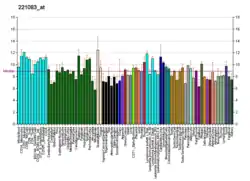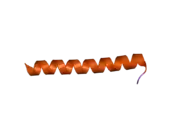KCNQ4
Potassium voltage-gated channel subfamily KQT member 4 also known as voltage-gated potassium channel subunit Kv7.4 is a protein that in humans is encoded by the KCNQ4 gene.[5][6][7]
Function
The protein encoded by this gene forms a potassium channel that is thought to play a critical role in the regulation of neuronal excitability, particularly in sensory cells of the cochlea. The encoded protein can form a homomultimeric potassium channel or possibly a heteromultimeric channel in association with the protein encoded by the KCNQ3 gene.[7]
Clinical significance
The current generated by this channel is inhibited by muscarinic acetylcholine receptor M1 and activated by retigabine, a novel anti-convulsant drug. Defects in this gene are a cause of nonsyndromic sensorineural deafness type 2 (DFNA2), an autosomal dominant form of progressive hearing loss. Two transcript variants encoding different isoforms have been found for this gene.[7]
Ligands
- ML213: KCNQ2/Q4 channel opener.[8]
See also
References
- GRCh38: Ensembl release 89: ENSG00000117013 - Ensembl, May 2017
- GRCm38: Ensembl release 89: ENSMUSG00000028631 - Ensembl, May 2017
- "Human PubMed Reference:". National Center for Biotechnology Information, U.S. National Library of Medicine.
- "Mouse PubMed Reference:". National Center for Biotechnology Information, U.S. National Library of Medicine.
- Kubisch C, Schroeder BC, Friedrich T, Lutjohann B, El-Amraoui A, Marlin S, Petit C, Jentsch TJ (Mar 1999). "KCNQ4, a novel potassium channel expressed in sensory outer hair cells, is mutated in dominant deafness". Cell. 96 (3): 437–46. doi:10.1016/S0092-8674(00)80556-5. PMID 10025409.
- Gutman GA, Chandy KG, Grissmer S, Lazdunski M, McKinnon D, Pardo LA, Robertson GA, Rudy B, Sanguinetti MC, Stuhmer W, Wang X (Dec 2005). "International Union of Pharmacology. LIII. Nomenclature and molecular relationships of voltage-gated potassium channels". Pharmacol Rev. 57 (4): 473–508. doi:10.1124/pr.57.4.10. PMID 16382104.
- "Entrez Gene: KCNQ4 potassium voltage-gated channel, KQT-like subfamily, member 4".
- Yu H, Wu M, Townsend SD, et al. (2011). "Discovery, Synthesis, and Structure Activity Relationship of a Series of N-Aryl- bicyclo[2.2.1]heptane-2-carboxamides: Characterization of ML213 as a Novel KCNQ2 and KCNQ4 Potassium Channel Opener". ACS Chem Neurosci. 2 (10): 572–577. doi:10.1021/cn200065b. PMC 3223964. PMID 22125664.
Further reading
- Coucke PJ, Van Hauwe P, Kelley PM, et al. (1999). "Mutations in the KCNQ4 gene are responsible for autosomal dominant deafness in four DFNA2 families". Hum. Mol. Genet. 8 (7): 1321–8. doi:10.1093/hmg/8.7.1321. PMID 10369879.
- Talebizadeh Z, Kelley PM, Askew JW, et al. (2000). "Novel mutation in the KCNQ4 gene in a large kindred with dominant progressive hearing loss". Hum. Mutat. 14 (6): 493–501. doi:10.1002/(SICI)1098-1004(199912)14:6<493::AID-HUMU8>3.0.CO;2-P. PMID 10571947.
- Selyanko AA, Hadley JK, Wood IC, et al. (2000). "Inhibition of KCNQ1-4 potassium channels expressed in mammalian cells via M1 muscarinic acetylcholine receptors". J. Physiol. 522 (3): 349–55. doi:10.1111/j.1469-7793.2000.t01-2-00349.x. PMC 2269765. PMID 10713961.
- Van Hauwe P, Coucke PJ, Ensink RJ, et al. (2000). "Mutations in the KCNQ4 K+ channel gene, responsible for autosomal dominant hearing loss, cluster in the channel pore region". Am. J. Med. Genet. 93 (3): 184–7. doi:10.1002/1096-8628(20000731)93:3<184::AID-AJMG4>3.0.CO;2-5. PMID 10925378.
- Beisel KW, Nelson NC, Delimont DC, Fritzsch B (2001). "Longitudinal gradients of KCNQ4 expression in spiral ganglion and cochlear hair cells correlate with progressive hearing loss in DFNA2". Brain Res. Mol. Brain Res. 82 (1–2): 137–49. doi:10.1016/S0169-328X(00)00204-7. PMID 11042367.
- Søgaard R, Ljungstrøm T, Pedersen KA, et al. (2001). "KCNQ4 channels expressed in mammalian cells: functional characteristics and pharmacology". Am. J. Physiol., Cell Physiol. 280 (4): C859–66. doi:10.1152/ajpcell.2001.280.4.C859. PMID 11245603.
- Van Camp G, Coucke PJ, Akita J, et al. (2002). "A mutational hot spot in the KCNQ4 gene responsible for autosomal dominant hearing impairment". Hum. Mutat. 20 (1): 15–9. doi:10.1002/humu.10096. PMID 12112653.
- Stern RE, Lalwani AK (2003). "Audiologic evidence for further genetic heterogeneity at DFNA2". Acta Otolaryngol. 122 (7): 730–5. doi:10.1080/003655402/000028059. PMID 12484650.
- Schwake M, Jentsch TJ, Friedrich T (2003). "A carboxy-terminal domain determines the subunit specificity of KCNQ K+ channel assembly". EMBO Rep. 4 (1): 76–81. doi:10.1038/sj.embor.embor715. PMC 1315815. PMID 12524525.
- Li Y, Langlais P, Gamper N, et al. (2004). "Dual phosphorylations underlie modulation of unitary KCNQ K(+) channels by Src tyrosine kinase". J. Biol. Chem. 279 (44): 45399–407. doi:10.1074/jbc.M408410200. PMID 15304482.
- Chambard JM, Ashmore JF (2005). "Regulation of the voltage-gated potassium channel KCNQ4 in the auditory pathway". Pflügers Arch. 450 (1): 34–44. doi:10.1007/s00424-004-1366-2. PMID 15660259.
- Van Laer L, Carlsson PI, Ottschytsch N, et al. (2006). "The contribution of genes involved in potassium-recycling in the inner ear to noise-induced hearing loss". Hum. Mutat. 27 (8): 786–95. doi:10.1002/humu.20360. PMID 16823764.
- Van Eyken E, Van Laer L, Fransen E, et al. (2006). "KCNQ4: a gene for age-related hearing impairment?". Hum. Mutat. 27 (10): 1007–16. doi:10.1002/humu.20375. PMID 16917933.
- Su CC, Yang JJ, Shieh JC, et al. (2007). "Identification of novel mutations in the KCNQ4 gene of patients with nonsyndromic deafness from Taiwan". Audiol. Neurootol. 12 (1): 20–6. doi:10.1159/000096154. PMID 17033161.
- Jensen HS, Grunnet M, Olesen SP (2007). "Inactivation as a New Regulatory Mechanism for Neuronal Kv7 Channels". Biophys. J. 92 (8): 2747–56. Bibcode:2007BpJ....92.2747J. doi:10.1529/biophysj.106.101287. PMC 1831682. PMID 17237198.
- Howard RJ, Clark KA, Holton JM, Minor DL (2007). "Structural Insight into KCNQ (Kv7) Channel Assembly and Channelopathy". Neuron. 53 (5): 663–75. doi:10.1016/j.neuron.2007.02.010. PMC 3011230. PMID 17329207.
- Iannotti FA, Panza E, Barrese V, Viggiano D, Soldovieri MV, Taglialatela M (March 2010). "Expression, localization, and pharmacological role of Kv7 potassium channels in skeletal muscle proliferation, differentiation, and survival after myotoxic insults". J. Pharmacol. Exp. Ther. 332 (3): 811–20. doi:10.1124/jpet.109.162800. PMID 20040580.
- Iannotti FA, Barrese V, Formisano L, Taglialatela M (Feb 2013). "Specification of skeletal muscle differentiation by repressor element-1 silencing transcription factor (REST)-regulated Kv7.4 potassium channels". Mol Biol Cell. 24 (3): 274–84. doi:10.1091/mbc.E11-12-1044. PMC 3564528. PMID 23242999.
External links
- GeneReviews/NCBI/NIH/UW entry on Deafness and Hereditary Hearing Loss Overview
- KCNQ4+protein,+human at the US National Library of Medicine Medical Subject Headings (MeSH)
- GeneReviews/NCBI/NIH/UW entry on DFNA2 Nonsyndromic Hearing Loss
This article incorporates text from the United States National Library of Medicine, which is in the public domain.






